Ely Bridge Tree Catcher (2022)
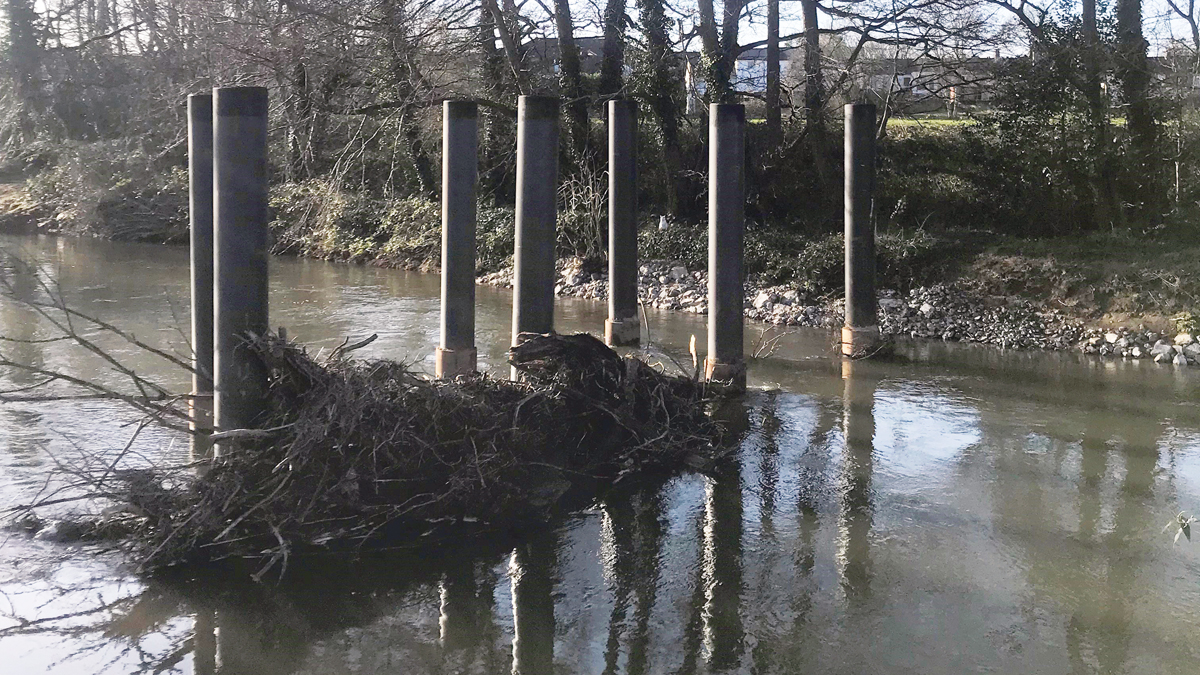
Ely tree catcher showing the staggered alignment of seven poles - Courtesy of Arup
As the River Ely flows towards Cardiff Bay, it passes under the A48 Cowbridge Road bridge in Cardiff. During periods of heavy rainfall, debris collects around the bridge’s central pier, reducing the capacity of the bridge and partially blocking the flow of the river. Blockages significantly increase flood risk locally, and once debris has accumulated, it cannot be removed safely at times of high flow. The surrounding area has suffered from a series of historic flood events causing damage to properties – most recently in 2020. Hydraulic modelling determined that, without intervention, around 495 properties were at risk of future flooding. Natural Resources Wales (NRW) commissioned Arup and Knights Brown to design and construct a solution to reduce the community’s flood risk.
An introduction to tree catchers
A tree catcher is an innovative way of trapping debris passing down a river following heavy rainfall and preventing it from accumulating at places where it might block the river’s flow. This approach can successfully mitigate flood risk to local properties caused by blockages, improves safe access for future maintenance, supports local biodiversity and retains the river’s amenity value for local communities.
Ely bridge tree catcher design – application of research
At the outset, the project team engaged proactively with NRW’s operatives who passed on observations of the tendency for woody debris to accumulate at the Ely Bridge pier to the Arup modelling team. This additional information was key to Arup building a better understanding of the sensitivity of the pier to blockage and the impact that the debris would have on flood risk, identifying blockages at the bridge to be the root cause of flood risk in the locality.
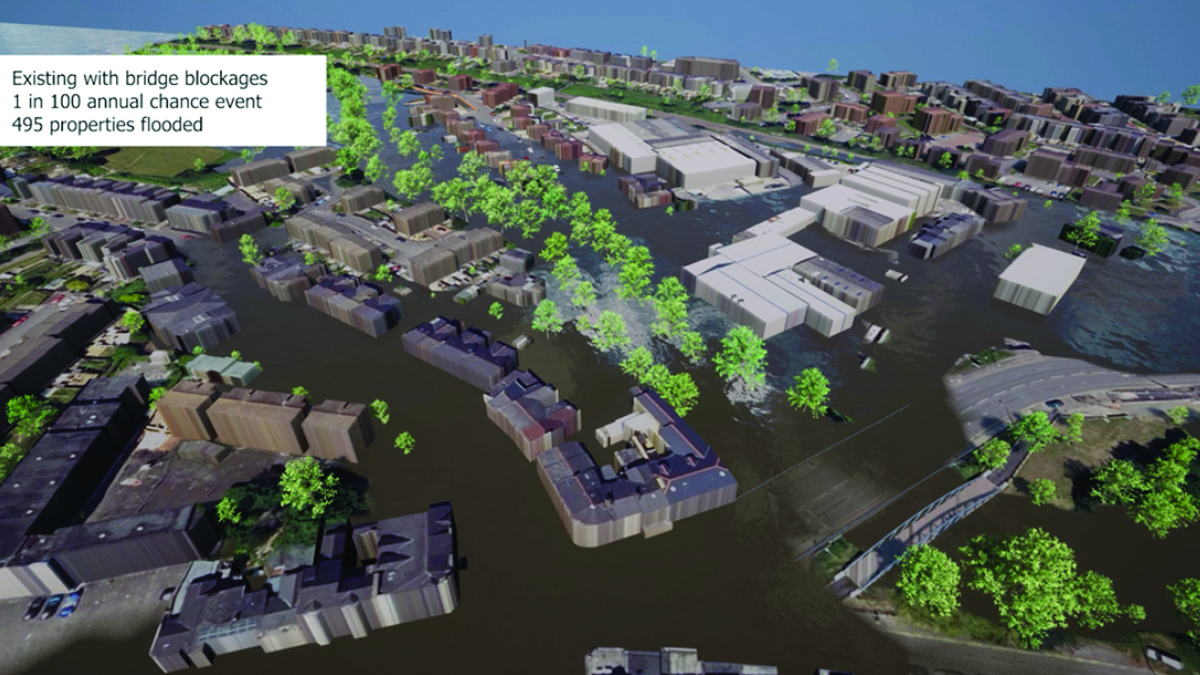
Model results illustrating the wide flood extent and property damage before any intervention – Courtesy of Arup
Arup were able to draw on international experience and best practice from debris-catcher designs used in other scenarios. The team adapted a debris-catching concept more commonly used to protect culverts and reservoir spillways, and applied it in a novel way to protect a bridge.
A horizontal boom tree catcher design was initially considered, although during consultation with the local community and consideration of operative and public safety, a multiple pole design was recognised to be more suitable.
The final tree catcher design consists of seven cylindrical poles spaced four metres apart in two staggered rows positioned upstream of the bridge. This design intercepts larger debris, preventing bridge blockages, while allowing smaller debris to continue to pass downstream, helping to minimise maintenance requirements, adapting best practice from the Environment Agency Trash and Security Guide, superseded in December 2019 by the CIRIA guide: Culvert, Screen and Outfall Manual. The staggered positioning of the tree catcher was inspired by the experience of the US Army Corp of Engineers, testing in Germany, and the British Dams Society.
A staggered alignment had been successfully deployed upstream of a flood-storage reservoir culvert outlet in Pickering, Yorkshire and has been shown to minimise the risk of hydraulic jumps arising.
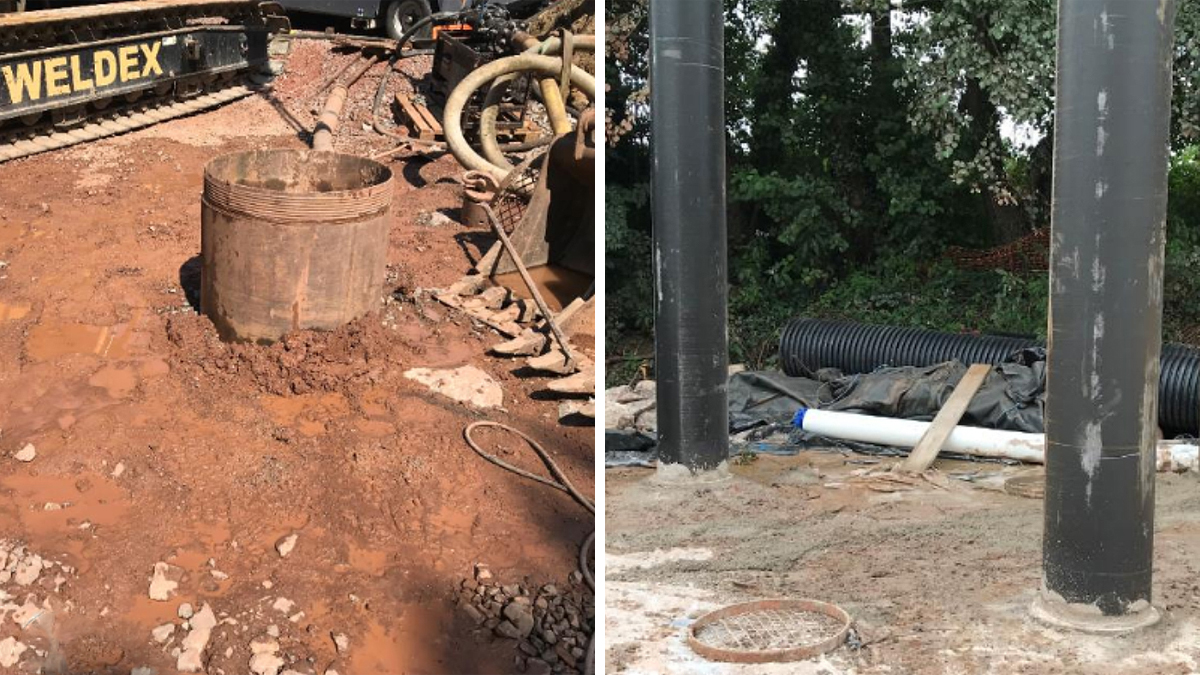
(left) Pile casing and (right) installation of tree catchers – Courtesy of Arup
The heights of the piled stanchions were determined from the modelling, to ensure sufficient allowance for climate change at the design 1 in 100 year flood. The ground investigation undertaken on the site identified that rockhead level would be encountered within the depth that the piles would need to be embedded. Driven piles were therefore, not considered to be appropriate, as these were unlikely to advance through the competent rock whilst also increasing the potential of noise or vibration pollution in the local area. As such, a bored pile solution was adopted.
To avoid any connection detail between the top of the pile and the base of the stanchion, which would require regular in-river maintenance and inspection, and would also be a weak point of the design, an innovative approach was adopted.
The pile was reinforced with a steel circular hollow section (CHS), that extends beyond the top of the pile and then forms the stanchion. Whilst this required consideration of how it would be lifted into position and held vertical while the concrete set, this had significant benefits in terms of design and safety.
A piling specification was produced, detailing a minimum toe level required to be achieved by the contractor to satisfy performance requirements of the piles, and information as to the loading that should be carried out under operation conditions.
The baseline scenario and the tree catcher solution were both assessed using a hydraulic model of the river and floodplain. The model was used to simulate both the ‘with blockage’ and ‘without blockage’ scenarios to better understand the impact of a blockage over a range of return periods. The hydraulic model was used to test different tree catcher locations. The representation of blockages and the uncertainty associated with the degree of blockage and hydraulic impacts of blockages was carefully considered.
There was initially found to be a minor residual flood risk impact, immediately downstream of the tree catcher under certain conditions; this was mitigated by raising the ground with a small blockstone wall.
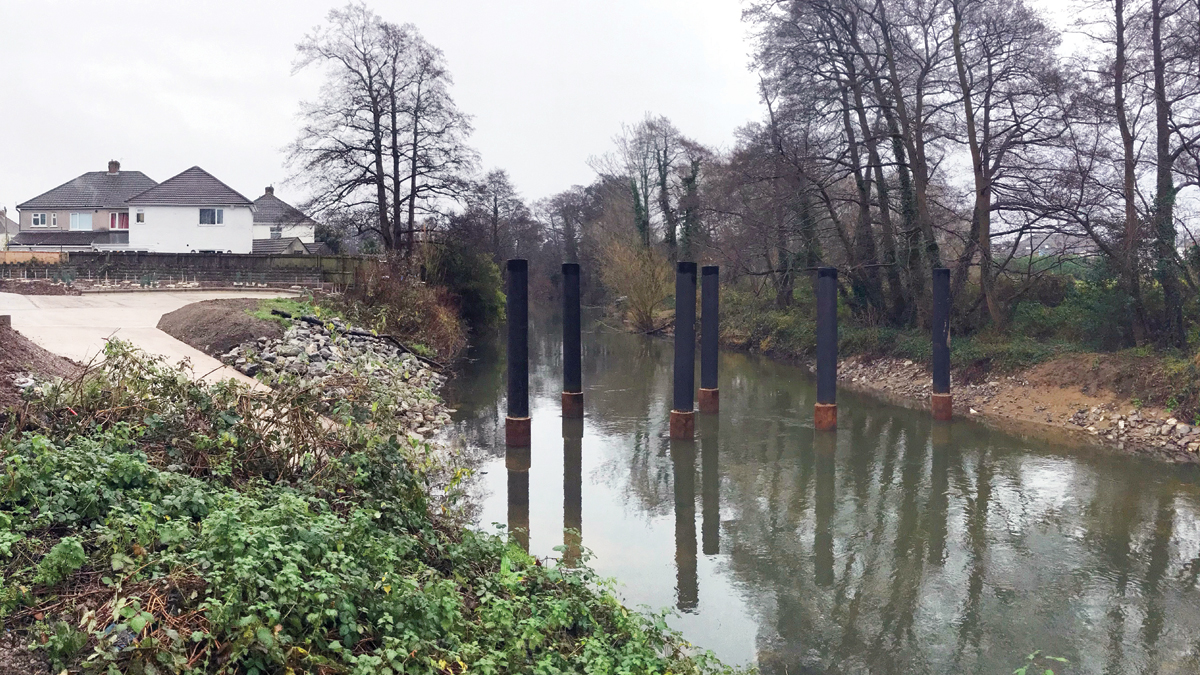
The completed tree catcher – Courtesy of Natural Resources Wales
Safe by design
During consultation, NRW and council operatives had highlighted that when debris began to build up at the bridge, unable to float due to the overhanging bridge deck, it was too dangerous to clear blockages until risky, high-water flows had subsided. This meant waiting for the flow to subside, and thereby increasing the risk of the flood boundary extending, before closing one of the main roads into Cardiff and reaching over the bridge with equipment to break up debris on the bridge. With the risks arising and disruptions caused by past practice, maintenance for any solution needed to be safe to execute at any time.
The design allows debris to accumulate at the tree catcher, which can be cleared safely by operatives following an event. The tree catcher proceeds to break up larger debris into smaller, less troublesome pieces during high flow events, allowing them to continue downstream without causing blockages.
A purpose-built track was also created to provide safe access for operatives. Further, the alignment of the poles has been designed in such a way that larger debris is directed towards the access track. This enables operatives to use their existing equipment to go to the bottom of the track, reach across to collect debris and remove it safely.
This approach means that debris needs clearing from the site less often while the installation of CCTV to monitor debris accumulation enables operatives to proactively manage the site, more efficiently and importantly, safely while local disruption is minimised.

(left) CCTV footage of Ely Tree Catcher and (right) CCTV footage at Ely Bridge on 22 February 2022 – Courtesy of Arup
Ely Bridge Tree Catcher: Supply chain – key participants
- Client: Natural Resources Wales
- Designer: Arup
- Contractor: Knights Brown
- ECC project management: Binnies
- Key process plant: McCarthy Construction Ltd
- Piling contractor: Van Elle
- Temporary works: AquaDam Europe Ltd
Construction
Site access: Access to the site was logistically challenging along a small residential road leading onto a cycle path. The cycle path was to be kept open throughout the programme requiring a phased approach to construction. Expectations were managed by a collaborative liaison with Knights Brown and Natural Resources Wales, delivering bilingual letters (both English and Welsh) to ensure thorough engagement. Complaints were strategically managed by NRW in collaboration with key stakeholders such as Welsh Government.
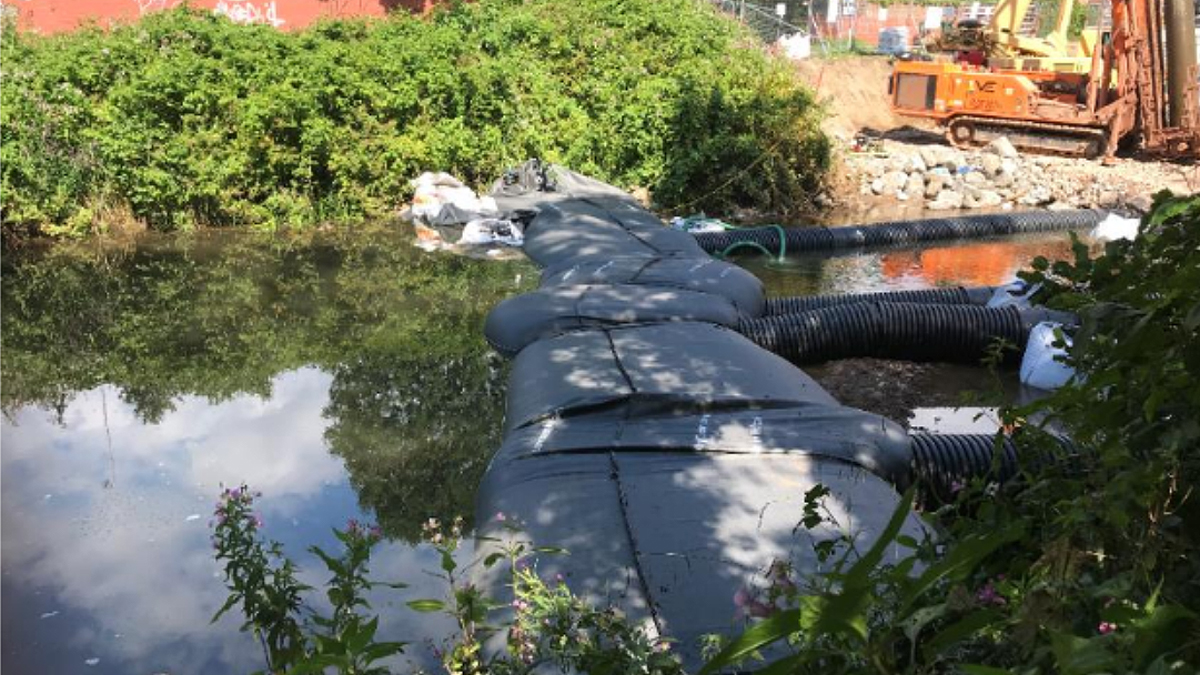
AquaDam – Courtesy of Arup
Ecology: Invasive species were widespread at the site requiring an invasive species management plan during construction. It was recommended that the contaminants are sprayed and cut down prior to works being carried out to facilitate movement on site during construction, although due to a tight programme, this was not possible here. An independent ecologist was present on site to verify that activities were carried out in accordance with management plans.
Environmental regulations required the site to be fish friendly and create minimal siltation and so, porous riprap, constructed with an AquaDam installation was chosen for the piling rig. A total of seven pipes were laid for flow continuation through the working area, however, since riprap was used for the piling rig, water made its way into the zone.
Piling: The piles were bored to depth and cased, acting as a permanent formwork solution whilst the circular hollow section was installed. The piles were initially cored to 4-5m within softer soils which provided a good holding frame prior to coring into the rock, a rock socket methodology. The challenge of coring through a soft and then hard stratum, which typically requires different coring methodologies, was tackled by utilising larger compressors for improved air flush to clear the kit.
The outer casings were filled with concrete prior to installing the circular hollow section to ensure that sufficient connection was achieved between the larger casing and the circular hollow section placed. The concrete specification had to be signed off by the regulator to ensure it was suitable for use within a marine environment, with a detailed method statement provided to demonstrate how the contractor would mitigate any overspill into the watercourse.
To help ensure that the verticality of each of the piles were within the tolerances for this scheme, it was vital that the piling rig was level. Spirit levels were utilised throughout construction to confirm accuracy and guide plates held forms in place during curing.
Ramp: Both Grasscrete and precast concrete were considered as materials for the maintenance ramp however both were ultimately discounted. Due to the high range in water levels at the site, the Grasscrete option risked washout of grass and seed, while precast concrete was avoided due to the potential for uplift and scour at this river location.
Consequently, a robust and durable inured concrete was preferred and bedded on riprap to facilitate an underwater construction. As inured concrete requires dry weather construction conditions to obtain the desired quality and level brush finish, thus the programme was carefully managed to avoid heavy rainfall, with pours scheduled for early morning, allowing the concrete to cure throughout the day.
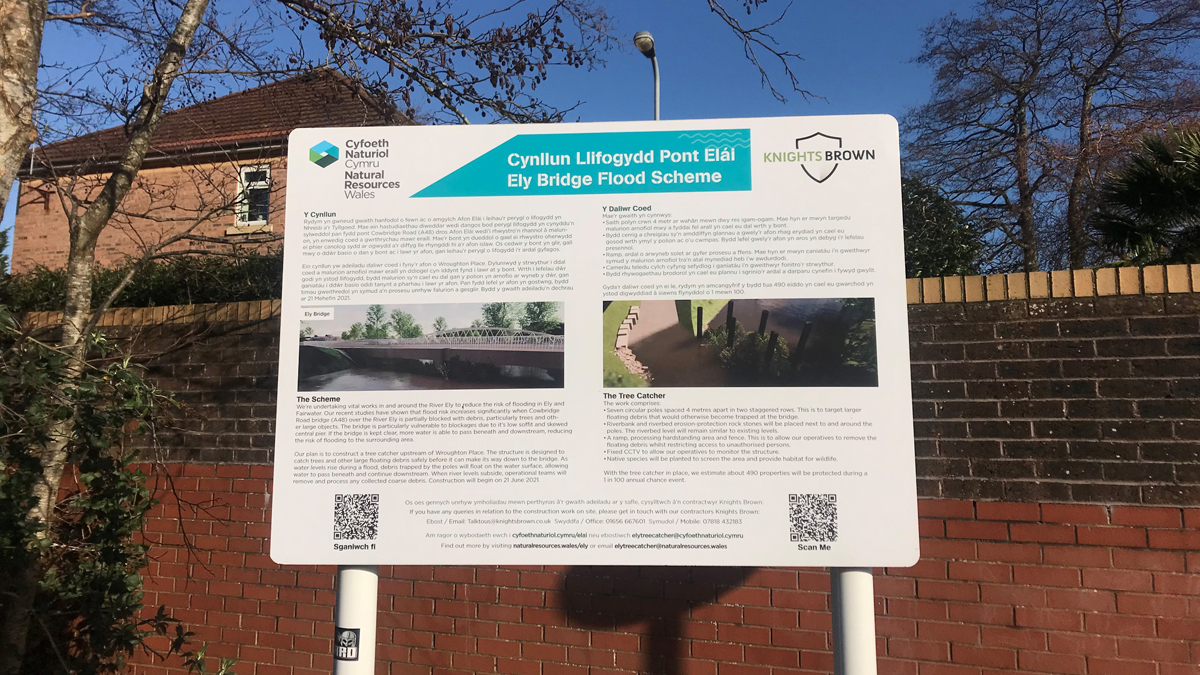
Story board on the riverside path adjacent to the structure – Courtesy of Arup
Communicating flood risk
Flood risk is a complex subject matter to communicate to local communities at risk. Further, tree catchers are a novel approach to managing flood risk, therefore requiring their reasoning to be explained in a clear, concise manner. An effective 3D visualisation of the narrative was produced and shared on the NRW websites and platforms. It was found that the visualisation resolved 75% of queries whilst also helping to educate others who frequently engage with the community, such as councillors and police, about the flood risk.
The engagement strategy helped demonstrate to the public how their safety was a priority to the authorities and how this scheme would tackle the issues and queries raised by their community. Today, a storyboard, next to the site, demonstrates the commitment NRW has to the communities.
Conclusion
The tree catcher design is a quarter of the cost, £957,000, of a traditional flood defence containment option and resulted in a 65% reduction in embodied carbon and construction impact. The project, delivered on time and to budget, was put to the test during several major, historic storms passing through Cardiff in the first few months of its operation from December 2021. As designed, there have been no blockages at the bridge.
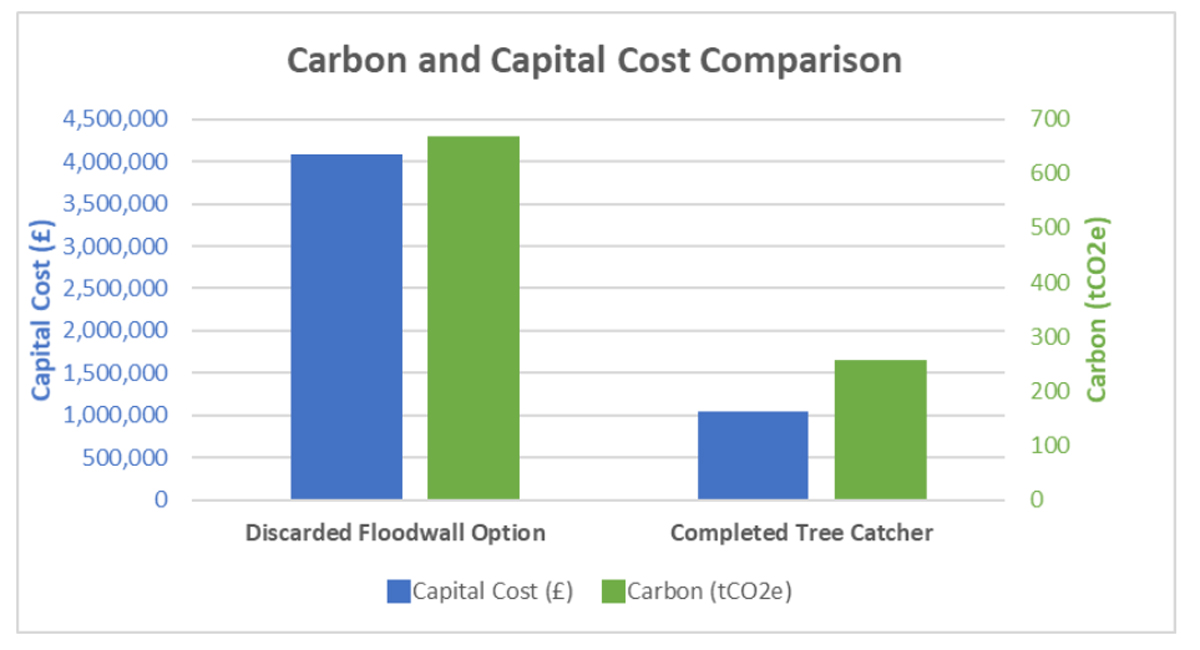
Carbon/cost comparison of floodwall vs tree catcher options – Courtesy of Arup
Tim England, NRW’s Flood Risk Manager, considers this scheme to be a great success where:
‘… a lot of properties benefit from this relatively small-scale scheme and there are few examples of this type of risk management approach.’
The project achieves maximum reduction in flood risk for minimum intervention and impact and has since been recognised by being short-listed for two Institute of Civil Engineers, Cymru awards.
The easily replicable, affordable and sustainable design has provided a solution that can be replicated globally and NRW is now exploring other locations within Wales where tree catchers can be implemented to mitigate flood risk.



